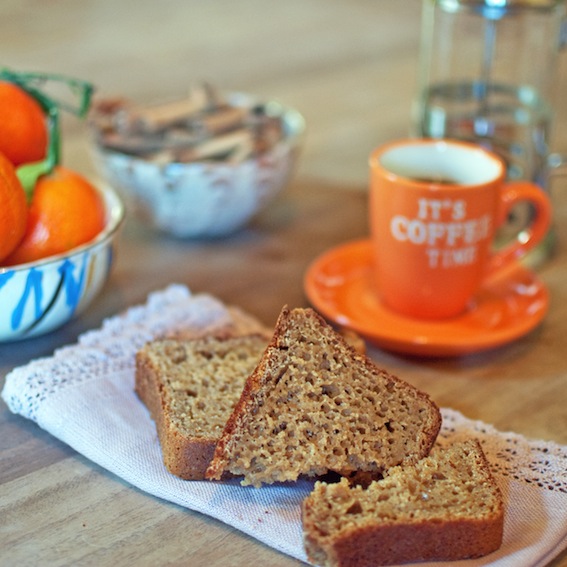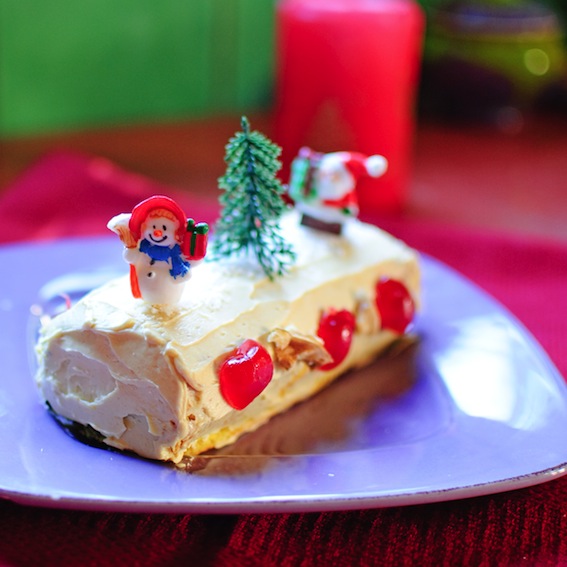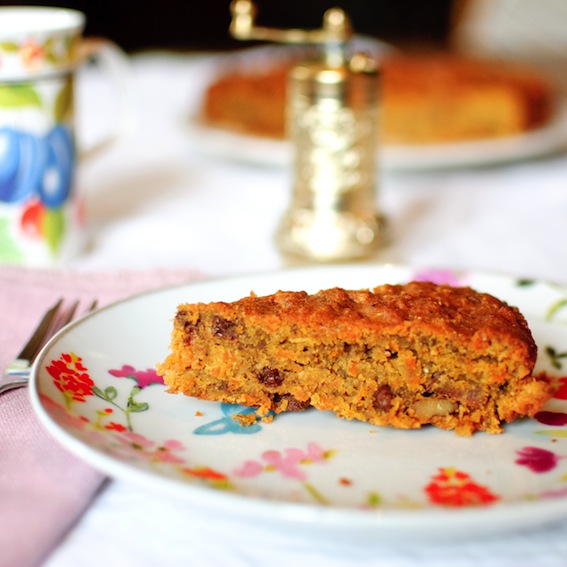-
Spicy coral lentil soup and a baguette of dubious provenance


I have been trying to convince myself that when Hugo helped himself to a baguette off the kitchen counter of the friends we were visiting last Sunday, it was his contribution towards dinner; a welcome accompaniment for the soup I’d made. And then I pulled my head out of the sand, removed my rose-tinted glasses and woke up and smelt the coffee: with no end of previous convictions to his name (including the time he stole no fewer than eight baguettes from a friend’s car), he’s nothing but a pathologically incorrigible food pilferer and I couldn’t be more embarrassed.

Ingredients (serves 6-8)
2 tablespoons of olive oil
1 large onion, sliced
2 leeks, washed and sliced
3 cloves of garlic
2 red peppers
2 carrots, peeled and sliced
2 teaspoons’ freshly grated ginger
1 teaspoon paprika (or piment d’Espelette)
sea salt and freshly ground black pepper
250g coral lentils
1.5 litres organic vegetable stock
Gently fry the onions, leeks and garlic in olive oil for a few minutes. Once golden brown, add the peppers, carrots, ginger and seasoning. Then add the lentils and pour the stock over the top. Simmer for 30 minutes and then purée. Serve with crispy baguette, if at all possible free of doggie dribble. -
Spice bread and watching a white hen unravel

Have you ever seen a hen unravel? I hadn’t, but I have now. A friend (I use the term loosely in hindsight) gave us four hens last week. When I say hens, obviously I mean butch, feathered, street-wise ladettes hell-bent on stealing the others’ food, staying up all night and generally causing mayhen (sorry!). Our white ‘head’ hen was not amused by their arrival and ‘greeted’ them with firmly-closed wings. As soon as she caught sight of them, she strutted purposefully over to the kitchen, squawking loudly until I opened the window. When I explained that it was OK, they had been invited, she wandered off for a mad, muttering walk on her own in the woods, head between wings. Even now, a week later, she comes to check with me everyday that these ruffians are still welcome and spends more time than usual on her perch, disdainfully looking down at them.

This spice bread is deliciously soothing, which is useful when you’re trying to console a hen with a grievance.
Ingredients
500g raw honey
250g spelt flour
2 teaspoons active dry yeast
½ teaspoon cinnamon
½ teaspoon ginger
½ teaspoon nutmeg
½ teaspoon coriander
½ teaspoon cardammon seeds
Zest of 1 lemon
2 free-range eggs, beaten
100ml milk
Preheat the oven to 220°C. Dissolve the yeast in two tablespoons of lukewarm water and set aside. Gently warm the honey, spices and zest until very runny (about 3 minutes). Place the flour in a mixing bowl, leaving a well in the middle. Add the yeast and then the beaten eggs and milk to the well, followed by the honey and spice mixture. Beat until you obtain a smooth, liquid dough. Transfer to a 1kg greased loaf tin and cook for 1 hour 15 mins. Cover the tin with aluminium foil once it is golden brown. It is best to leave the bread in a tin to rest at room temperature for at least three days before eating. -
Sausage casserole and confusing coat conundrums

I have a new ski jacket. While I’m sure you’re over the moon for me, I admit that this is hardly groundbreaking news. It is, however, very confusing for Hugo. For him, the precursors to ‘walkies’ are: my digging around for an embarrassingly long time in a futile attempt to locate my mobile ‘phone, resorting to ringing it (of course it rings in my my pocket), locating vaguely matching left and right shoes and then, in Winter, putting on The Walking Jacket. My new jacket occasions a perplexed ‘head-tilt to one side’ look of utter bemusement, accompanied by a woefully despondent ‘maybe we’re not going for a walk after all’ sigh. He’d better get used to it though — with my matching left and right shoes and new jacket, there’s no stopping me; I’ve become a bit of a fashionista and may even upgrade again next year! 😉
There’s something in this sausage casserole for everyone: high-maintenance fashionistas, fussy children, finicky dogs and hens… It is adapted from a Tana Ramsay ‘Family Kitchen’ recipe.
Ingredients (serves 6)
2 tablespoons of olive oil
1 large onion, peeled and sliced
2 cloves of garlic
6 mushrooms, peeled and sliced
6 Toulouse sausages
60g pancetta, sliced
1 leek, rinced and sliced
Sea salt and freshly ground black pepper
1 tablespoon paprika
2 teaspoons Worcester sauce
1 litre chicken or vegetable stock
6 carrots, peeled and cut into 3cm pieces
6 small potatoes, peeled
200g, cannelloni beans, pre-cooked and drained
½ green cabbage, shredded
Gently heat the olive oil in a large casserole dish (Dutch oven), adding the sausages, onions mushrooms and garlic and fry until golden brown. Add the pancetta and leeks, continuing to brown. Then add the seasoning and stock, followed by the carrots, cabbage, potatoes and beans and bring to a boil. Leave to simmer for about 40 minutes. May be served alone or with bread, couscous, quinoa or basmati rice. -
2013 in review
The WordPress.com stats helper monkeys prepared a 2013 annual report for this blog.

Here’s an excerpt:The concert hall at the Sydney Opera House holds 2,700 people. This blog was viewed about 34,000 times in 2013. If it were a concert at Sydney Opera House, it would take about 13 sold-out performances for that many people to see it.
-
Spelt yule log (bûche de Noel) and an unidentified thigh thief

I can’t believe I’m admitting to this, but our Christmas lunch was stolen by an unidentified creature. We had put the guinea fowl, which had been slaughtered, plucked and frozen by our neighbour in November, to defrost on top of a very tall fridge in the grange. At the time, it was the proud owner of two wings and two thighs. Anyway, bad plan because when I went to get it the next morning it was minus a thigh. As we don’t have a cat, I can’t imagine what sort of animal could have climbed a slippery surface that high; it definitely wasn’t Hugo because he suffers from vertigo. My money’s on a carnivorous giraffe. Admittedly there aren’t many in Southwestern France, but it’s the only thing that makes sense. Luc, my husband, was all for cooking and serving it as an amputee delicacy, claiming that the cooking process would kill any lingering giraffe germs, but I put my foot down and we located a beautifully intact capon in a shop in the village, conveniently open on the 25th December no doubt in case of such incidents.
This ‘bûche de Noel’, which is similar to a roulade, is the traditional French Christmas dessert. It should be kept under lock and key IN THE HOUSE until you’re ready to eat it!
For the sponge:
Ingredients
4 free-range eggs
180g cane sugar
1 teaspoon vanilla extract
160g spelt flour
1 teaspoon baking powder
Raspberry jam to fill
Preheat the oven to 200°C and prepare a Swiss roll tin by lightly greasing and lining the base and sides with a large sheet of greaseproof paper, pushing it into the corners. Beat the eggs, vanilla extract and sugar together until thick and creamy and then add the spelt flour and baking powder, incorporating well. Spoon the mixture into the tin and bake in the preheated oven for nine minutes. Once baked, remove from the oven and immediately roll into a spiral on a floured-surface. Unroll and spread generously with raspberry jam. Roll again and set aside.
For the butterceam icing:
Ingredients
125g butter, softened
60g cane sugar
2 egg yolks
2 teaspoons of coffee powder, diluted in two teaspoons of water
Pour the sugar into a saucepan, lightly moisten with a few drops of water and cook for about six minutes, stirring constantly. Stop just before the mixture caramelises. Beat the egg yolks and add the hot sugar little by little until the mixture whitens. Beat the butter well and gradually add the egg yolk/sugar mixture. Finally, add the coffee, incorporating well. Cover the rolled cake with the buttercream, spreading with a spatula, decorate with walnuts and glazed cherries and leave to cool for at least an hour in the fridge before serving. -
Simple coconut chicken curry and a fine way to drive

No doubt in retribution for the gentle mockery in my last post, I received a speeding fine this morning in the post. Or to be precise, my husband received a speeding fine, which absolutely thrilled him. The irony is that I was flashed coming back from a very active skiing weekend and traffic cop-in-the-making, Léo, was fast asleep and not in a position to attend to his functions. Of course, the problem with radar tickets is that you can’tflirtnegotiate your way out of them. If I’m stopped by an actual live policeman, I play the ‘oh gosh I’m so sorry officer —it must have been a slip of the foot during a fleeting blonde moment’ card. Shiny grey metal boxes, however, are not nearly as indulgent with lame excuses.
I like my curry the way I like my driving: fast and hassle-free. It is none the less delicious for it though.
Ingredients (serves four)
1 tablespoon coconut oil
4 chicken breasts, cut into chunks
1 onion, thinly sliced
2 cloves of garlic, crushed
4 carrots, peeled and cut
2 green chillies, chopped
1 tablespoon of peeled, grated fresh ginger
1 kaffir lime leaf (or bay leaf)
1 cinnamon stick
½ teaspoon turmeric
3 teaspoons cumin seeds
1/2 teaspoon sea salt
1/2 teaspoon freshly ground black pepper
100ml chicken stock
100ml coconut milk
Gently fry the onion, garlic and chicken in the coconut oil for a few minutes in a medium-size casserole dish. Add the seasoning and spices (cumin seeds, salt, pepper, ginger, turmeric, cinnamon stick…) and continue to brown, stirring frequently. Add the carrots and chillies and then the chicken stock and coconut milk. Simmer for about 20 minutes and then serve with basmati rice, naan bread, chickpea pancakes or just a green salad. -
Rum and raisin carrot cake (gf) and frustrated traffic wardens

Word is out that I’m a bit of a rebel behind the wheel. Unfortunately I’m also married to, as my father puts it, a ‘repressed traffic warden’. He does have a point — how many people do you know that tell their guests to go and repark their cars within the confines of meticulously-placed traffic cones? (I blush to admit that we own traffic cones.) After our trip to San Sebastian, where I received more than one dressing-down for my mutinous driving, in particular U-turning, I’m now getting reflections from Léo’s friends. I drove one of them to his music lesson the other day and, in the time it took to drive about half a kilometre, he gleefully pointed out that I had entered the car park ‘the wrong way’, driven too close to the pavement and stopped in a disabled parking space. What can I say?
This carrot cake, although healthy and no-doubt sickeningly law-abiding, is deliciously moist and fragrant.
Ingredients
3 eggs
100g coconut sugar
2 teaspoons vanilla extract
200g ground almonds
100g dessicated coconut
2 teaspoons ground cinnamon
2 teaspoons freshly grated ginger
100g walnuts, roughly chopped
100g raisins
2 tablespoons rum
70g coconut butter, melted
70g butter, melted
200g carrots, grated
Preheat the oven to 140°C and prepare a 24cm cake tin. Place the raisins in a small saucepan and cook in the rum for about five minutes. Break the eggs into a mixing bowl, add the coconut sugar and vanilla extract and beat well. Add the ground almonds, coconut and spices, combining well. Stir in the melted butter and coconut oil, the walnuts and the raisin/rum mixture. Finally add the carrots and mix until everything is well combined. Transfer the mixture to the cake tin and cook for between 50 and 60 minutes (a fork should come out clean once cooked). -
Petits pots au chocolat (chocolate pots), abject terror and an egg dearth

Hugo’s in a bit of a bad place at the moment. He frequently wakes to the resonance of hunting rifles (beyond unsettling for a dog of his delicate mental constitution) and will only deign to go outside if accompanied. On Sunday morning, no doubt in his eternal quest for reassurance, I found him in bed with Léo. Needless to say, he had not been greeted with open arms.
Since the hens, although of sound mind, are enjoying a long sabbatical, I had to concoct an egg-free chocolate mousse solution. This is it:
Ingredients (makes 6 small pots)
150g organic dark chocolate (min 70% cocoa solids)
200ml coconut cream, chilled
20g salted butter
1 teaspoon rum (optional)
2 tablespoons agave syrup
5g agar agar
Whip the coconut cream well until it becomes fluffy. Break the chocolate into small pieces and melt it and the butter in a bain marie with the rum and agave syrup. Meanwhile, dissolve the agar agar in a small quantity of hot water (4 tablespoons), bring to the boil and simmer for a few minutes. Combine the whipped cream and chocolate mixture thoroughly. Then add the agar agar, mixing well. Transfer to small pots (or cups) and chill in the fridge for at least three hours before eating. -
Pot-au-feu (French beef stew) and disruptive mothers

Tennis tournament season is back and, once again, I’m in the market for a gag. If I don’t find one (and let’s face it, there seems to be a dearth of reasonably stylish ones), I’ll have to stop accompanying Léo to matches until I learn to control my gratuitous and unhelpful comment reflex, which never fails to kick in. I can only be thankful that the majority of the other spectators don’t understand English; I won’t go into details as I wouldn’t want to sully reputations, particularly mine. The strange thing is that neither Léo nor I are particularly competitive, but there’s something about people either criticising or applauding (I don’t know which is worse) my son’s ‘faults’ that brings out the devil in me.
This is a simple version of ‘pot-au-feu’, a traditional French dish which, strictly speaking, should include several different cuts of meat as well as oxtail. In any case, it is very comforting after a day spent in the cold having your nerves ripped to shreds! It used to be that the pot containing the stew would stay cooking over the fire nearly all winter, with bits and pieces being constantly replaced. Usually the ‘bouillon’ or sauce is eaten as soup and the vegetables and meat as a main course with mustard and pickles, although I like to eat the two together.
Ingredients (serves 4)
1 tablespoon olive oil
2 onions, sliced
2 cloves of garlic, chopped
Vegetable stock (roughly 500ml)
1kg stewing beef, cut into large cubes
4 leeks, washed and sliced
1 red pepper (optional), cut into slices
1 stick of celery, cut into four pieces
6 small carrots, cut into 3cm pieces
2 swedes or turnips, peeled and quartered
¼ white cabbage, sliced
4 small potatoes, peeled
Bouquet garni (parsely, thyme, bay)
Sea salt and freshly ground black pepper
1 teaspoon piment d’espelette (or paprika)
Preheat the oven to 150°C. In a fairly large casserole dish (Dutch oven) brown the onions and garlic very briefly in the olive oil. Add the beef and continue to brown for a couple of minutes. Add all the vegetables (except the potatoes) and then enough vegetable stock to cover. Add the seasoning, herbs and spices and bring to a gentle boil. Transfer to the oven and cook for about three hours, checking from time-to-time that there is sufficient liquid (the vegetables should be covered). Add the potatoes and cook for a further hour. -
Raw honey and learning when to stop talking

We went to a local Christmas market this weekend and, while I was busy buying my own bodyweight in locally-produced Landaise honey, Léo was busy consuming his bodyweight in garbure (a duck and vegetable soup typical of Southwestern France). The quantities of food that Léo consumes and the enthusiasm with which he does so, are becoming acute sources of embarrassment to me — you would honestly think that he wasn’t fed at home. Sometimes, for example, we drop into a local café at about 11am for a cup of coffee and he orders a three-course ‘menu du jour’. I desperately feel the need to justify his appetite and end up woefully tying myself in knots with comments like: ‘I do feed him at home you know! In fact I feed him extremely well!’. On realising that this sounds horribly pretentious, I might add: ‘When I say extremely well, obviously I mean, you know, normally. Well not out-of-a-packet normally, but, errr, very healthily’. Of course I end up sounding like a furiously back-pedalling crazy person who should probably learn when to shut up.
Anyway, back to honey. Honey has been used for its healing properties since biblical times when it was used, amongst other things, to treat diphtheria. Physicians of ancient times, such as Aristotle, Hippocrates and Cornelius made reference to its healing qualities. A recent Russian study showed that beekeepers in Georgia who consumed raw honey and pollen on a regular basis frequently lived to over 100, a few even living as old as 150.
Raw honey is honey that has not been heated, pasteurised or processed in any way. It is alkaline-forming and contains a multitude of vitamins, minerals, amino acids, enzymes and powerful antioxidants as well as other natural nutrients. It also contains the enzyme amylase, which aids in the digestion of starch. A piece of toast spread with honey, for example, is more easily digestible than a piece of toast without as the enzymes in the honey ‘predigest’ the starch. (Beware of pasturised honey, which is more or less equivalent to refined sugar.)
Raw honey has anti-viral, anti-bacterial and anti-fungal properties. It promotes general health as well as digestive health and also strengthens the immune system. It helps to control allergies and is an excellent remedy for skin wounds and all types of infections. It can also stabilise blood pressure, balance sugar levels, relieve pain, calm nerves and has been used to treat ulcers. It is an expectorant and has anti-inflammatory properties which means that it is useful in the treatment of respiratory conditions such as bronchitis and asthma.
The different varieties of honey have varying properties as well as quite distinctive aromas. Here are a few:
Acacia, a light and clear honey, is one of the most popular and sweetest honey varieties because of its mild delicate floral taste. Due to its low sucrose content, it is a good choice for diabetics. Acacia cleanses the liver, regulates the intestine, and has an anti-inflammatory action on the respiratory system.
Buckwheat honey is a dark, full-bodied and rich in iron. It contains a higher percentage of antioxidants than other honeys and is perhaps the strongest and darkest of all varieties.
Heather honey is thick, amber in color and has one of the strongest and most pungent flavours. It is fragrant and floral with a very lingering aftertaste that is almost bitter. Prized since ancient times due to its medicinal properties, heather honey is extremely high in protein.
Linden honey is pale yellow in colour with a distinctive yet delicate fresh woody scent. Due to its sedative quality, it is effective in the treatment of insomnia and anxiety. It may also be used to treat colds, coughs and bronchitis.
Pine Tree honey is not overly sweet, has a strong aroma and is rich in minerals and proteins.
Thyme honey’s healing benefits are second to none. It is currently being used in hospitals in France for its infection-fighting, powerful antioxidant properties. A 2009 Greek study found thyme honey to reduce the viability of both endometrial and prostrate cancer cells..
Wildflower honey can vary in colour from very light to dark its flavour ranges from light and fruity to tangy and rich, depending on the mix from the different seasonal wildflowers.
Raw honey should not be given to children under a year old as they lack the stomach acid to de-activate any bacteria.